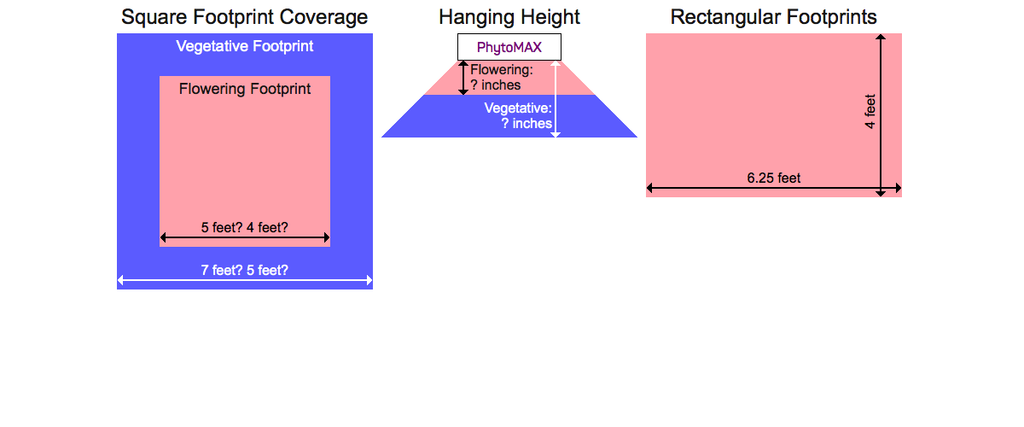Determining the Ideal LED Grow Light Setup

- Plant / crop:
- Light demands
- Photoperiod (day / night hours)
- Growing area:
- Size
- Shape
- Your goals:
- Vegetative, flowering or both?
- Economize vs. maximizing yield
- Active growth vs. maintenance
Plant Lighting Intensity and Duration
Different species of plants (and sometimes even different varieties or cultivars within species) require different amounts of light for ideal growth, and flowering plants often require more light while flowering and fruiting than during vegetative growth.
The total amount of light received by a plant each day is determined by both the intensity of the light and the duration of the illumination. For example, if you have a light running for 2 hours per day, it only takes 1 hour for a light that is twice as intense to create the same total amount of light.
To measure the total amount of light per day, the Daily Light Integral (DLI) counts the total number of photons per day in the PAR (Photosynthetic Active Radiation) range of 400-700nm. DLI is measured in units of mol ·m-2 ·d-1 [moles of light (mol) per square meter (m-2) per day (d-1), where 1 mole of light is roughly 6*1023 photons].
For every plant there is a DLI range which will maximize growth and production; less than this range will result in poorer growth / yield or even no growth, and more DLI will be wasteful (costing more than the additional yield justifies), or even harmful to the plant. Determining this ideal DLI range is tricky as it not only depends on the plant type and growth stage, but can also vary with other factors in your growing environment such as temperature, humidity, fertilization / nutrient availability, CO2 supplementation, the exact lighting spectrum (including outside of the PAR range measured by DLI), and more. This deserves an entirely separate in-depth discussion, coming soon.
Complicating matters more, plants can be divided into 3 categories:
- Short-day plants flower when the night length is greater than their critical period; until then, they stay in a vegetative growth mode. Cannabis sativa, Cannabis indica, cotton and rice are examples of short-day plants.
- Long-day plants flower when the night length falls below their critical period. Peas, lettuce and carnations are examples of long-day plants.
- Day-neutral plants do not initiate flowering based on the night length, but instead on some other stimulus such as reaching a particular size or age, or period of cold or drought. Cannabis ruderalis ("auto-flowering" cannabis), peppers, tomatoes and cucumbers are examples of day-neutral plants.
LED Grow Light Intensity and Coverage
Each model of our PhytoMAX lights uses 5W LEDs to create light. The average light output (intensity) per LED is the same; the larger models simply have more of them to create more light. All Black Dog LED lights are designed to spread the light as evenly as possible over the entire lighting footprint; the intensity of the light within the footprint and the size of the footprint are controlled by how high you hang the light above the plants. Moving the light closer to the plants will decrease the size of the footprint but increase the intensity because you're spreading the same amount of light over a smaller area. Moving the light further from the plants increases the size of the footprint but decreases the intensity. No matter what size light you're using, you can get an equivalent percentage increase in DLI by either shrinking the footprint area or increasing lights-on hours. For example, you can get a 25% increase in DLI by shrinking the covered footprint by 25% (e.g. from 16 square feet to 12 square feet2 square meters to 1.5 square meters), or by increasing the hours the light is on by 25% (e.g. from 12 hours to 15 hours).Growing Area Shape
Our PhytoMAX lights have a square footprint area, but that doesn't mean you can't use them in rectangular growing areas. There are three options for covering non-square areas:-
Use a light big enough to cover the longest dimension:
- For slightly-rectangular LED grow light coverage this can be the least-expensive option. Using reflective materials on especially the longer sides of your growing area will help to make use of all of the light in this setup. If your growing area's longest side is more than 1.5 times the length of the shorter side, you probably want to use option number 2 or 3 for better, more-economical results.
Slightly Rectangular Footprint Coverage with a Large LightImperial MetricPhytoMAX 8005 feet150 cm4 feet120 cm -
Use multiple lights:
- By hanging two or more lights side-by-side you can create a rectangular footprint. For example, two PhytoMAX 200's hung 2.5 feet76 cm apart (on center) will cover a 2.5 x 5 foot76 x 152 cm rectangular area, using our maximum recommended flowering footprint for photoperiod-sensitive Cannabis. In a partial combination with option #1 above, these same two lights could also cover a 2.5 x 4 foot76 x 120 cm area, a 2 x 5 foot60 x 150 cm area, or even a 2 x 4 foot60 x 120 cm area.
Rectangular Footprint Coverage with Multiple LightsImperial MetricPhytoMAX 200PhytoMAX 2005 feet150 cm2.5 feet75 cm -
Use a light mover to "stretch" the footprint shape:
- Hanging the light from a light mover will change the shape of the light's effective footprint. The actual footprint is still square, but by moving this square footprint back and forth in a line, it is effectively transformed into a rectangle. Often the cost of an appropriate larger light with a light mover is less than the cost of two smaller lights without a light mover, making it the most economical choice for many rectangular growing areas. Light movers have a lot of benefits and considerations, detailed below:
Using a Light Mover to Cover a Rectangular FootprintImperial MetricPhytoMAX 8006.25 feet190 cm4 feet120 cm
LED Grow Lights on Light Movers
Light movers are beneficial for two reasons:-
Changing the effective shape of a light's footprint:
- By moving a light back and forth in a line, light movers "stretch" the effective footprint of a light into a different shape, as long as you keep the effectively-covered footprint area the same. For example, a PhytoMAX 800 can normally cover a 5 x 5 foot area (25 square feet)150 x 150 cm area (2.25 square meters) when it isn't on a light mover, but moving it back and forth can make it cover a 4 x 6.25 foot120 x 190 cm area or a 3 x 8.3 foot90 x 245 cm area (both 25 square feetroughly 2.25 square meters), although each setup requires a different light hanging height above the plants. When on a light mover, the light should ideally be hung at the appropriate height to get a square footprint as wide as the shortest side of the effective rectangular footprint area. For example, to cover a 4 x 6.25 foot120 x 190 cm area, the PhytoMAX 800 hung from the light mover should be hung at the appropriate height for a 4 x 4 foot120 x 120 cm footprint (24 inches61 cm above the average height of the canopy). This square footprint is moved by the light mover to create the rectangular effective footprint.
Imperial Metric
Using a Light Mover to Cover a Rectangular FootprintPhytoMAX 8006.25 feet190 cm4 feet120 cmSide ViewPhytoMAX 800Height: 24 inches61 cm -
Increasing light distribution to raise yield
- When a light is hung overhead in a static (un-moving) manner, plants will naturally orient their leaves to catch as much light as possible. This often results in upper leaves shading out the lower leaves and flowers of the same plant. To some extent this issue can be overcome by increasing the intensity of the light, but by simply moving the light back and forth and mimicking the sun's natural daily traversal of the sky, light can be more evenly and efficiently delivered to all leaves on the plant. We've seen 10-20% increases in yield when a light is on a light mover covering the same size area, even when the light isn't being moved very far.To some extent, hanging multiple un-moving lights provide many of the same benefits; having the light come from many angles helps to nourish more of the lower leaves. However, placing multiple-light setups on light movers will still increase light distribution and yield.
Large Areas
When setting up larger growing areas, it is important to consider plant access. You'll need to be able to reach the plants to take care of them and even just to harvest them; we generally recommend setups with no more than a 4 foot120 cm reach to access any plant. This generally requires aisles in larger grows, unless the plants are on movable carts to allow on-demand creation of aisleways. In general, the ideal setup for larger growing areas minimizes aisle space while still allowing easy access to all plants. This requires adjustment for the exact size and shape of the area, as well as the placement of doorways. The staff at Black Dog LED have decades of experience setting up larger growing operations and we're always happy to help with lighting setup design; simply contact us or call us at 720-420-1209!Your Goals
The ideal LED grow light setup for your situation depends on what you want out of your grow, for example:- Growth phase use: vegetative, flowering or both? If you want to use the growing area for only vegetative or flowering, you only need to consider the lighting intensity for that growth phase. When using the area for both phases of growth, it is best to design for the most light-demanding phase (usually flowering).
- Economize vs. maximizing yield: once the plants' minimum lighting requirements (DLI) have been met, increasing the DLI will increase yield. Up to a point, increasing the DLI by a certain percentage will increase yield by a "linear" equivalent percentage; for example increasing the DLI by 10% may increase yield by 8%, and increasing DLI by 20% would increase yield by 16%. When you start giving the plants as much DLI as they can handle, this yield return on increased intensity starts to fall off and is no longer linear; for example if you've got a very high DLI to begin with, increasing it by 10% may only give a 4% increase in yield. Past a certain point increasing the DLI will not increase yield at all, and may even hurt it if the plants are being harmed by too much light.
The Perfect LED Grow Light Setup
A configuration calculator is coming soon! For now, here are some basic recommendations, based on flowering daylength-sensitive Cannabis plants. Four different configurations are given for each of our PhytoMAX light models:- Minimum: At this DLI configuration, we're sure you'll be happy with the results; plants will grow and flower vigorously with dense, high-quality flowers. Yes, you can go below this a bit (increase footprint size and hanging height) and still get decent results, but they won't be up to our standards.
- Medium: At this DLI configuration, we're sure you'll be thrilled with the results; quality may go up slightly and yield per square footmeter will go up.
- High: At this DLI configuration, you're still going to see an increased yield per square footmeter roughly equivalent to the increased DLI, although by "overdriving" the plants with so much light you may need to pay a lot more attention to your plants to ensure they're happy. Maintaining proper watering, fertilization, pruning and support becomes more critical as the DLI increases, so we would not recommend this level for beginning growers. Increasing DLI beyond this point will probably not result in a linear rise in yield, and the grams per watt yield will probably start to decrease, and costs go up.
- Extreme: At this DLI configuration, you're probably maximizing yield per square footmeter, but in terms of yield per watt of electricity used (grams per watt) you'd probably be better off spreading the light out over a larger area or more plants. We would not generally recommend raising DLI above this point as it is most likely going to be wasteful, although every growing situation is different, and unique growing techniques may make use of all this light!
Imperial Metric
| Light | Light Amount (DLI) for Flowering Photoperiod-Sensitive Cannabis | |||||||
|---|---|---|---|---|---|---|---|---|
| Minimum | Medium | High | Extreme | |||||
| Footprint | Hanging Height | Footprint | Hanging Height | Footprint | Hanging Height | Footprint | Hanging Height | |
| PhytoMAX 1000 | 5.5 x 5.5 feet (30.25 ft168 x 168 cm (2.8 m2) | 32 in.81 cm | 4.5 x 4.5 feet (20.25 ft137 x 137 cm (1.9 m2) | 26 in.66 cm | 4 x 4 feet (16 ft122 x 122 cm (1.5 m2) | 24 in.61 cm | 3.75 x 3.75 feet (14.1 ft114 x 114 cm (1.3 m2) | 22 in.56 cm |
| PhytoMAX 800 | 5 x 5 feet (25 ft152 x 152 cm (2.3 m2) | 29 in.74 cm | 4 x 4 feet (16 ft122 x 122 cm (1.5 m2) | 24 in.61 cm | 3.5 x 3.5 feet (12.25 ft107 x 107 cm (1.1 m2) | 20 in.51 cm | 3.25 x 3.25 feet (10.6 ft100 x 100 cm (1 m2) | 19 in.48 cm |
| PhytoMAX 600 | 4.25 x 4.25 feet (18 ft130 x 130 cm (1.7 m2) | 25 in.64 cm | 3.5 x 3.5 feet (12.25 ft107 x 107 cm (1.1 m2) | 20 in.51 cm | 3 x 3 feet (9 ft91 x 91 cm (0.8 m2) | 17 in.43 cm | 2.75 x 2.75 feet (7.56 ft84 x 84 cm (0.7 m2) | 16 in.41 cm |
| PhytoMAX 400 | 3.5 x 3.5 feet (12.25 ft107 x 107 cm (1.1 m2) | 20 in.51 cm | 3 x 3 feet (9 ft91 x 91 cm (0.8 m2) | 17 in.43 cm | 2.5 x 2.5 feet (6.25 ft76 x 76 cm (0.6 m2) | 14 in.36 cm | 2.25 x 2.25 feet (5.06 ft69 x 69 cm (0.5 m2) | 13 in.33 cm |
| PhytoMAX 200 | 2.5 x 2.5 feet (6.25 ft76 x 76 cm (0.6 m2) | 14 in.36 cm | 2 x 2 feet (4 ft61 x 61 cm (0.4 m2) | 12 in.30 cm | 1.75 x 1.75 feet (3.06 ft53 x 53 cm (0.28 m2) | 10 in.26 cm | 1.7 x 1.7 feet (2.9 ft52 x 52 cm (0.27 m2) | 9.5 in.24 cm |






